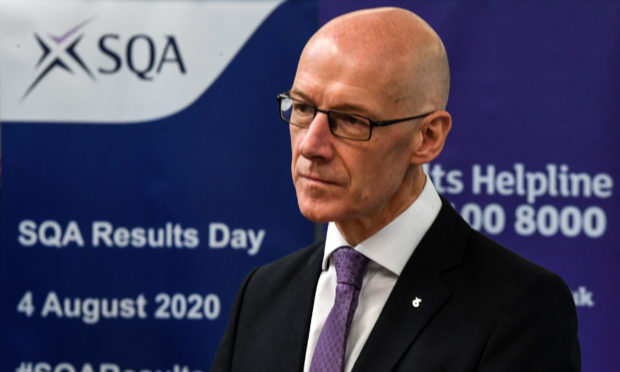With a decision on the 2021 exam diet imminent we take a look back over a historic year which saw thousands of grades modified by the Scottish Qualifications Authority.
Education Secretary John Swinney is set to outline the plans to the Scottish Parliament this afternoon.
Parents, teachers and pupils have been eagerly awaiting the announcement – but why is there uncertainty over whether exams will go ahead in May?
We take a look over the key events that have led us to Mr Swinney’s announcement.
Exams cancelled in a historic move
The coronavirus pandemic forced the closure of schools in March – leaving the question of exams up in the air.
Exams were cancelled for the first time in history on March 19 however Mr Swinney announced pupils would still receive accreditation for their hard-work.
Instead, grades were to be calculated using the professional judgement of teachers, with estimated grades submitted to the SQA based on pupils’ activity over the school year.
A quarter of results altered by SQA
Results day came on August 4 for pupils studying National 5s, Highers and Advanced Highers.
Many young people celebrated their achievements but others were disheartened to learn their predicted grades were altered by the SQA. The criteria included historic performance of schools.
However over 133,000 results – a quarter of the total – were modified by the exam board, with 93.1% downgraded and 6.9% upgraded.
Parents, teachers and politicians called for the grades to be reinstated over fears pupils from the country’s poorest areas had been disadvantaged.
There was a 15% gap between the actual and estimated pass rate for children in the most deprived areas, compared to 7% for those in the least deprived areas.
In Dundee, pupils with equal abilities but from contrasting areas of Dundee were awarded different grades, according to city tutors, with some of the poorest students being awarded D grades or fails.
Grades adjusted to ensure ‘credibility’ – Sturgeon
First Minister Nicola Sturgeon said the positive of the exam results was that pupils from the most deprived areas had also seen an increase in their pass rates overall.
Figures estimate around 70% of pupils from the country’s most deprived areas passed their Highers, which is an increase on around 65% from 2019.
But in justifying the need for SQA intervention, Ms Sturgeon said it was to ensure grades were fair in line with previous years.
On August 4, she said the SQA altered grades to ensure the system remained “credible”.
The rate of attainment at grades A to C would have increased by a scale “never been seen” before in the history of exams, if left unaltered.
At the time, a government spokesperson said: “We believe we have delivered fairness to learners, through a consistent, evidence based approach in the absence of exams.
“We have maintained the integrity and credibility of our qualifications system, ensuring that standards are maintained over time, in the interest of learners, through judicious moderation of grades.”
Government U-turn following criticism
On August 11, Mr Swinney said he had heard the views of the public and would now be withdrawing the controversial moderation process.
He said he was directing the SQA to “reissue those awards solely on teacher and lecturer judgement”.
Pupils would receive a new award certificate to reflect the change.
Following the revision of results, the pass rate for National 5 had risen to 88.9%, 89.2% for Higher and 93.1% at Advanced Higher.
Uncertainty over 2021 exams
As schools returned, Mr Swinney said he hoped to offer clarity over the upcoming exam diet as soon as possible.
However by the end of the first term for many, pupils and teachers were still in the dark over possible changes.
The uncertainty has led to calls from headteachers to cancel exams in 2021 to help pupils catch up with their courses.
Teachers have also been asked to prepare for the possibility of exams being scrapped by ensuring they monitor pupils’ performance over the year.
The SQA received over 23,000 responses to an online consultation outlining possible changes to courses for the academic year.
The plans include a wide variety of changes to individual subjects, including alterations to coursework, assignments and exam structure and length.
The guidance was due to be released on August 31, however the publication was delayed to allow for a review of this year’s exam diet by Professor Mark Priestley.












